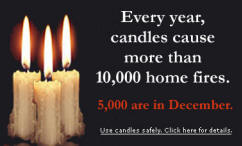

candle safety


Materials most easily ignited by candles are:
Mattresses and bedding Cabinetry Curtains and Drapes Interior Wall Coverings Upholstered Furniture Event Decorations Clothing Magazines Newspapers and Writing Paper Rugs and other Floor Coverings TowelsBeware of Lead Wicks
A paraffin candle sometimes has lead
in the wick's core, which you can
spot by looking for a thin wire in
the center of the cotton wick. Lead
matter is emitted when the candle
burns. This is distressing news in
light of the fact that 100 percent
of lead inhaled from candlewicks is
absorbed into the bloodstream.
The Journal of the
American Medical Association
suggests that families exposed to
candles with metallic wicks should
have their blood-lead levels
checked.
Children are
particularly vulnerable to lead
poisoning. Chronic low-level
exposure can produce permanent neuro-psychological
defects and behavior disorders,
including low IQ, short attention
span, hyperactive behavior and motor
difficulties. As for adults, early
signs of poisoning include
gastrointestinal problems, muscle
pains and weakness, irritability,
excessive thirst, headache,
insomnia, depression and lethargy.
People with asthma or lung or heart
diseases are especially susceptible
because even small amounts of lead
particles can aggravate their
condition.
Candles are enjoyable, calming and fragrant, but don't ever forget that when you burn them, you are dealing with fire. Always take proper precautions to prevent your enjoyable experience from turning into a disaster.
The number of home fires started by candles has increased dramatically in the last ten years. According to the National Fire Prevention Association the number of fires caused by candles in homes throughout the country increased from 5,460 in 1990 to 11,600 in 1997 - the most recent year for which data are available. Ironically this increase occurred during a period in which home fires in general are on the decline. U. S. consumers spent over $2.3 billion on candles during the year 2000. Since the candle-making industry has grown (and continues to grow) at a rate of about 10 to 15% annually, opportunities for home fires will increase even further unless consumers become more aware of the potential for danger that candles pose if they are not used in accordance with established safety procedures.
Most of these candle-caused fires
started when lit candles were left unatte nded, or
because some form of combustible material was left too
close to the candle, or because children were playing
with the candles or something flammable near the
candles. Five percent of home candle fires started when
the occupant fell asleep while the candle was burning.
Almost half of all candle fires start in the bedroom.
nded, or
because some form of combustible material was left too
close to the candle, or because children were playing
with the candles or something flammable near the
candles. Five percent of home candle fires started when
the occupant fell asleep while the candle was burning.
Almost half of all candle fires start in the bedroom.
Contact us
| Call (574) 272-2144 |
| Fax (574) 272-4043 |
| Write: 18355 Auten Rd South Bend, IN 46637 |
| Police-Fire-EMS-Dial 911 |
STAFF
Office Hours
| Monday-Friday 8:00 a.m. to 4:00 p.m. |
|
Evening Information For all Non-emergency information during evening and weekend hours please leave a message with duty shift. Your call will be answered on the next day's regular business hours. |
 e.
e.